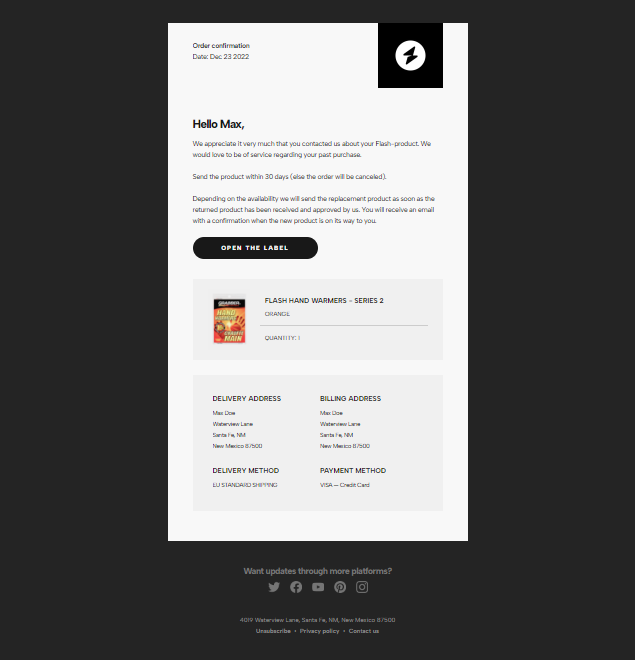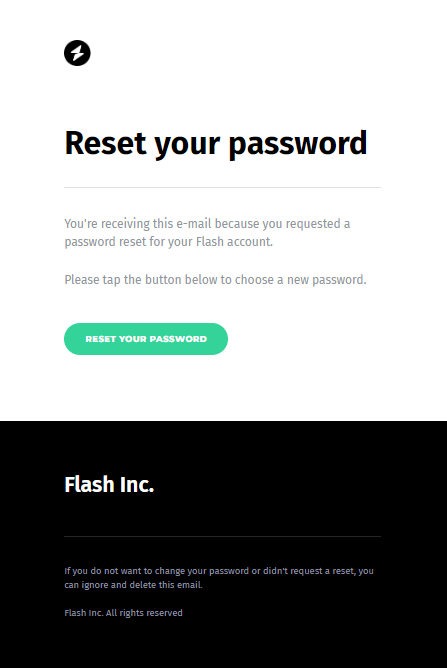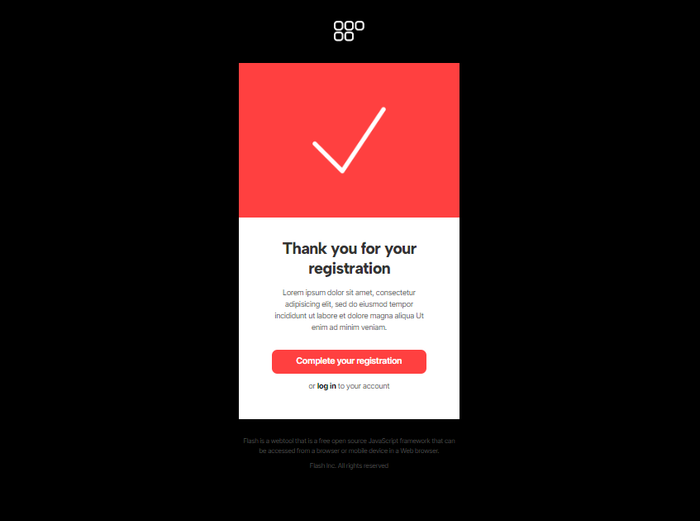Transactional email templates
Check out our free transactional email templates for all your business needs, from orders to payments, shipments, and more. You can also design your own free HTML transactional email template for your brand with Tabular's email builder.
Old-fashioned shops have been replaced by online stores, and traditional customer communication has shifted to emails. Transactional email templates are now the backbone of the email marketing industry. You don’t have to be a marketing expert to learn how to connect with your customers; simply start by sending a couple of emails, which will only take a minute. Just select one of the free transactional email templates; sign up, customize the HTML template for your brand, and send.
What is a Transactional Email
Transactional email templates are pre-designed emails that are ready to be sent, either automatically or manually. The main purpose of transactional emails is to inform users about an agreed-upon transaction or interaction between them and the business. These emails can also be highly effective in encouraging free users to make purchases or upgrade to premium memberships.
Transactional email templates are sent to users based on specific triggers, such as when they open an account or an abandoned cart.
Transactional Emails vs. Marketing Emails
| Transactional Emails | Marketing Emails | |
|---|---|---|
| Purpose | Sent based on a user's action (e.g., purchase, password reset) to provide critical information about the action taken. | Sent strategically to promote products, engage recipients, or drive new actions like purchases or signups. |
| Content & Personalization | Highly personalized content relevant to the user's specific action (e.g., order confirmation, shipping info). | Promotional content with a broad focus to engage recipients and drive conversions, less personalized. |
| Trigger & Sending Method | Triggered automatically by user actions and sent through SMTP relay or APIs for real-time communication. | Sent manually or scheduled for bulk sending to mailing lists as part of campaigns, often using email marketing platforms. |
| Examples | Order confirmation, Password reset, Shipping notifications | Sales promotions, Newsletters, Event invitations |
| IP Address & Deliverability | Often sent from a dedicated IP address to ensure high deliverability and avoid issues related to low engagement. | Typically, separate IPs are used due to lower engagement rates that may affect overall deliverability. |
Types of Transactional Email Templates
1. Order Confirmation Emails

- Sent immediately after a purchase is made.
- Includes details like order summary, payment confirmation, and delivery information.
2. Shipping Notifications Emails

- Updates customers on the status of their shipment.
- Provides tracking numbers and expected delivery dates.
3. Password Reset Emails

- Triggered when a user requests to reset their password.
- Contains secure links or instructions to update login credentials.
4. Account Registration Emails

- Welcomes new users to the platform.
- May include account details and next steps.
5. Subscription Confirmations

- Sent when a user subscribes to a service or newsletter.
- Confirms the subscription and outlines what to expect.
6. Invoice and Billing Emails

- Provide detailed billing information and payment receipts.
- Essential for record-keeping and transparency.
7. Feedback and Survey Requests
- Encourage users to provide feedback on their experience.
- Help businesses gather valuable insights.
Best Practices for Transactional Email Templates
Transactional email templates play a crucial role in the success of your email marketing campaigns. Even a welcome email, with beautifully designed CTAs, a carefully written subject line, and professional branding, can drive the biggest sale of the month. So, let’s learn how to design effective transactional email templates.
Transactional Email Call to Actions
- Use contrasting colors so users can clearly see the message.
- Use action-oriented language, like "Shop Now" or "View Your Order."
- Keep it short and strong; be imperative.
- Make the design responsive for all screen sizes and devices.
- Utilize white space to create a captivating and modern look.
Transactional Email Design
- Transactional email templates are there to evoke or respond to user actions. Optimizing each email template for specific actions and content planning is crucial.
- When it comes to designing HTML transactional emails, the main concern is not how they look but how they perform. Keep your designs simple yet professional, making everything easy to navigate and follow.
- Your code might be the reason why your emails are not performing. Before sending out emails, compile and check your code in major email service providers.
- Host your visuals properly, nobody wants to see a broken frame.
Tabular.email allows you to build transactional email templates without writing code. You can also choose from one of our free templates and easily customize it.
Responsive Design
- Use mobile-first design, over 55% of email readers open emails on their mobile devices.
- Use single-column layouts and consider landscape mode.
- Implement full-width options to adjust to screen sizes.
- Avoid fixed-width elements.
- Design buttons that are easily clickable and readable on mobile.
- Test for both Android and Apple devices.
Setting Up Transactional Email Delivery and Automation
Setting Up Email Delivery
When it comes to setting up email delivery for transactional emails, there are several options to consider. One option is using a transactional email provider, such as SendGrid or Mailgun, which specializes in high-volume email delivery and provides advanced features for tracking and managing transactional emails. If you already have an existing email marketing platform that allows for transactional automation, you can integrate it with your transactional emails to streamline your email management processes.
Transactional email providers offer dedicated infrastructure and advanced analytics, making them a suitable choice for businesses with high email volumes or complex requirements. Integrating with an existing email marketing platform allows you to leverage its features and seamlessly manage both marketing and transactional emails in one place.
To configure the email delivery settings, follow these steps:
- Set up an account with the selected email service provider (ESP).
- Create your transactional emails in Tabular and utilize your email service provider's personalization variables.
- Connect your Tabular account to your ESP account. This allows you to automatically upload your emails to your ESP.
- Use the templates to send your transactional emails programmatically triggered via your server back-end or use a visual automation interface if your marketing software provides allows for.
Automating Transactional Emails
Automating transactional emails brings several benefits, including efficient and timely delivery, personalized communication, and improved customer experience. By automating transactional emails, you can ensure that the right emails are sent at the right time, without the need for manual intervention. This saves time and resources while ensuring consistent and timely communication with your customers.
Triggers or event-based automation allows you to send transactional emails based on specific customer actions or events. For example, you can automatically send a welcome email when a new user signs up or a confirmation email when a purchase is made. This ensures that transactional emails are triggered instantly, providing relevant information to customers when they need it most.
To set up automated workflows for transactional emails, follow these tips:
- Identify the key customer actions or events that should trigger transactional emails.
- Map out the customer journey and determine the appropriate emails for each stage.
- Select an email automation platform that supports transactional email automation.
- Set up the triggers or events within the automation platform, specifying the conditions that will initiate the emails.
- Customize the email templates and content to align with the specific triggers and customer actions.
- Test the automated workflows to ensure the emails are triggered correctly and contain the intended content.
- Monitor the performance and effectiveness of the automated transactional emails, making adjustments as needed.
How to Design Transactional Email Templates
I can imagine you’ve chosen your color palette based on psychology and branding, and you already have a logo. However, you still need several types of email templates. Let’s learn how to design them.
- Consistency across different marketing channels is key to successful branding. Always use your color palette, fonts, and have a similar approach for all design materials to maintain brand authority.
- Create a visual hierarchy to make your CTAs and key content, like listings, stand out. As mentioned before, prioritize performance over aesthetics.
- Option for simple layouts to keep the design easily navigable, clean, and uncluttered
- Use high-quality images that load quickly, and don't forget the image alt text. Rendering issues are common in email marketing, and alt text helps users understand the content if the images fail to load.
- Accessibility is everything. Design your email templates with your users in mind. For example, if your audience segmentation shows that many users are over 60, consider making your headings larger for easier readability.
Marketing is about finding those who need what you offer and helping improve their lives. A responsive, well-designed HTML transactional email template with a clear CTA and strong subject line is key to success. Users respect your products if you respect your brand, keep designs consistent across all channels.
Tabular helps you create effective HTML email templates without coding. Its drag-and-drop builder allows you to create responsive templates that work seamlessly across all major email services.

















